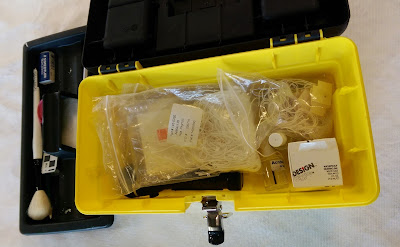 |
| Part of the Pharmaceutical Collection Photo Courtesy of {Sarah Sutton} |
This week we started the process of "unpacking"
the CHF Museum's Pharmaceutical Collection objects, both metaphorically and
literally. The CHF Museum has a pharmaceutical collection containing items like
foot corn cream, asthma medication, cough syrup, and even something called
"freckle cream". These medicines date from the early 1900s till the 1990s.
Currently, the collection is not in good condition - meaning that the objects
are not being stored according to best practices, and we will need to re-house
and repack the objects. There are six boxes containing the 249 objects within
this collection, so you can imagine how stuffed the medicines are in the boxes
and trays. Some of the medicines are leaking and damaged, while others are in
amazing condition. This week we started a new project with this collection, and
are formulating a plan on what to do next in order to properly care for these
objects. This blog will be Part One of a small series of our steps to "unpack"
the pharmaceutical collection.
 |
| The mysterious Freckle Cream. This brand is actually still manufacturing cream for the removal of freckles. Photo Courtesy of {Sarah Sutton} |
 |
| Photo Courtesy of {Sarah Sutton} |
This week Stephanie and I started our first steps toward
creating a safer environment for both the collection, and those who come into
contact with it. The pharmaceutical collection includes very old medicine which
may or may not become more potent with time. Some medications have the
potential to deteriorate with time, and others become more dangerous. Medicines
can off-gas, meaning that they release potentially harmful gases into the air
and around other collections. There is also the potential for micro-climates to
develop around the medicines. There are indeed medicines in the collection
which are poisonous. In the early twentieth century it was common for medicines
to contain formaldehyde, mercury, or chloroform - all of which are present in
the CHF Museum's collection. Because of this, the collection is full of materials
that we would deem hazardous. The
first step in correcting any museum collection issue is assessing the situation at hand. Stephanie and I needed to go
through the collection piece by piece to see what's going on with the
medicines, check the conditions of the objects, photograph the ingredients in
the medicines, and heat-seal any leaking or dangerous medicines in specialized polypropylene bags.
We first started by moving the collection from storage into a work space that is
ventilated for our protection, because we had no idea about how harmful the
collection could be. We took each object out of the archival boxes one by one
to photograph the object, assess its condition, and read some ingredients. If
the condition was poor, or if the ingredients show harmful materials, like
mercury or strychnine, we would then seal the medicine in a polypropylene bag
to protect the medicine and the rest of the collection. (To see what this machine looks like, click HERE). This type of plastic is
used in museums all over the world. Polypropylene allows the medicines to
breathe so a microclimate cannot form within the bag, and the bag will not expand
due to gas release. But, the bag remains liquid resistant, so the medicine will
not leak all over the rest of the collection.
 |
| Our Tool Kit Photo Courtesy of {Sarah Sutton} |
After we went through the six boxes of medicines and related
materials, we made sure to thoroughly clean the museum cart, laptop, and camera
we were using to ensure that none of the hazardous materials would be brought
to the museum team workroom. We also wore gloves throughout the process. This
first step was important because we are now able to articulate what exactly is in the collection and the
condition of the collection. We were able to confirm all of the objects that
are on a catalog list that I made on PastPerfect, and we sealed away the
dangerous or leaking medicines to further protect the rest of the collection
and those who come into contact with it. We are now able to figure out what our
next steps should be for re-housing the collection, and how to work with
hazardous materials. The next posts that are part of the Pharmaceutical
Collection blog series will highlight: how to handle and store hazardous
materials/museum collections, best practices in storing medicines and hazardous
materials, how to dispose of hazardous museum materials, how to reach out to,
and embrace the advice and guidance of colleagues in the field, and how to
write a policy regarding the collection and maintenance of hazardous materials.
I will also be blogging a small literature review which will go over the
materials I have been reading to learn about best practices for storing
hazardous materials, and safety in handling these objects. Finally, I will be
relating what I learn regarding hazardous materials and collecting medicines to
Pennhurst and my thesis research.

Comments
Post a Comment